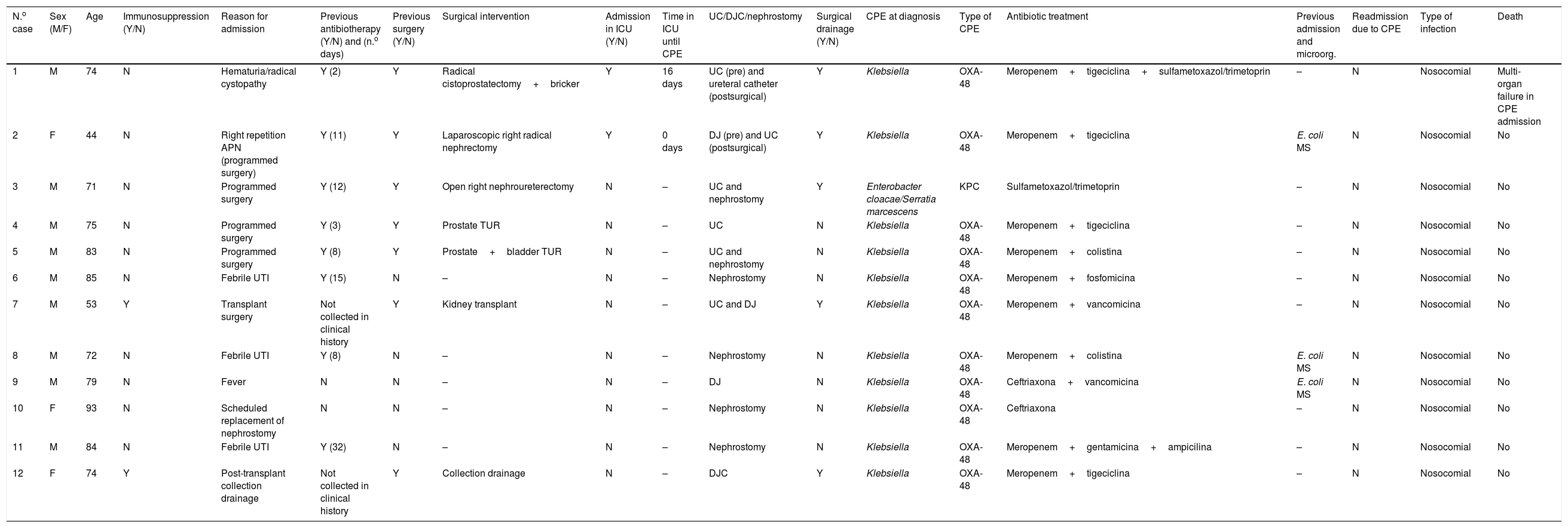To analyze infections by carbapenemase-producing enterobacteriaceae (CPE) and describe the characteristics and potential risk factors associated with patients of a department of urology.
Materials and methodsObservational and retrospective study. The inclusion criterion was hospitalization in our department of Urology between August 2013 and December 2016. We analyzed those patients who were positive for CPE in at least 1 culture. We reviewed their baseline characteristics, risk factors and variables such as the presence of previous urinary tract infections, subsequent readmissions, the microorganism, type of CPE, treatment, origin (hospital or community) and mortality.
ResultsOf the 5657 patients who met the inclusion criterion, a CPE was isolated in 12 cases. CPE infections represented 3.6% of all healthcare-associated infections and 9.7% of those caused by enterobacteria. The analyzed factors associated with CPE infection in our series were the presence of urinary catheters (100%), undergoing surgery (58.3%), previous ICU admission (8.3%) and immunosuppression (16.6%). In terms of mortality, 8.3% of the patients who presented CPE infection died during hospitalization.
ConclusionsApproximately 10% of enterobacteria present a carbapenemase-resistance pattern in urological patients in our setting. Carrying a urinary catheter and/or undergoing surgery are risk factors associated with the development of these infections in urological patients in our setting. CPE infections increase morbidity and mortality.
Analizar las infecciones por enterobacterias productoras de carbapenemasas (EPC) y describir características y posibles factores de riesgo asociados con los pacientes de un servicio de urología.
Material y métodosEstudio observacional y retrospectivo. El criterio de inclusión fue haber estado ingresado en nuestro servicio de urología entre agosto de 2013 y diciembre de 2016. Se analizaron aquellos que presentaron positividad para EPC en al menos un cultivo. Se revisaron características basales y factores de riesgo. Asimismo se revisaron variables como presencia de infecciones urinarias previas, reingresos posteriores, el microorganismo, tipo de EPC, tratamiento administrado, un origen hospitalario o comunitario y la mortalidad.
ResultadosDe los 5.657 pacientes que cumplían criterio de inclusión, en 12 casos se aisló una EPC. Las infecciones por EPC representaron un 3,6% del total de infecciones relacionadas con la asistencia sanitaria y un 9,7% de las producidas por enterobacterias. Los factores analizados asociados a infección por EPC en nuestra serie son: presencia de catéteres urinarios (100%), haber sido sometido a tratamiento quirúrgico (58,3%), ingreso previo en UCI (8,3%) e inmunosupresión (16,6%). Con relación a la mortalidad, un 8,3% de los pacientes que presentaron infección por EPC fallecieron durante el ingreso.
ConclusionesAproximadamente un 10% de las enterobacterias presenta patrón de resistencia a carbapenemasas en el paciente urológico de nuestro medio. Ser portador de catéter urinario y/o someterse a una cirugía son factores de riesgo asociados al desarrollo de estas infecciones en el paciente urológico de nuestro medio. La infección por una EPC eleva la morbimortalidad.










